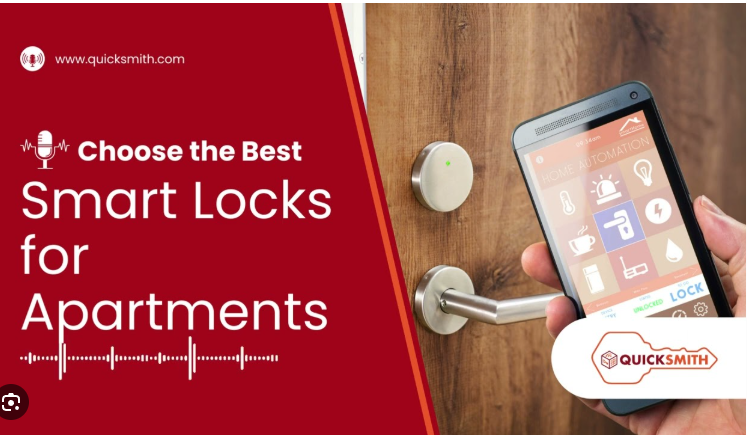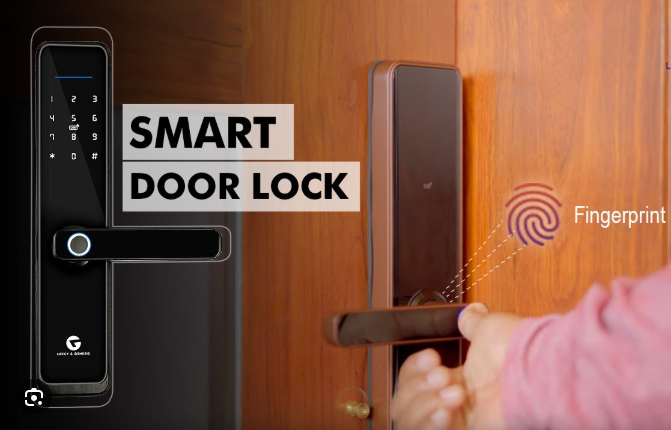Learning how to use smart lock in apartments can transform your rental experience with enhanced security and convenience. A smart lock is an electronic lock that connects to your smartphone or smart home system via WiFi or Bluetooth, offering keyless entry through PIN codes, key cards, or fingerprint scanning. In 2025, smart locks are ideal for apartment dwellers seeking modern, renter-friendly security solutions without permanent door modifications.
Why focus on how to use smart lock in apartments? Smart locks offer flexibility for renters, allowing easy access management for roommates or guests while maintaining security. This beginner-friendly smart lock setup guide covers smart lock installation, app connection, and troubleshooting, tailored for apartment doors, which are often wooden. Whether you’re new to DIY smart lock installation or upgrading your apartment’s security, this guide ensures you can install smart lock on wooden door and use it effectively. Let’s dive in!

What You Need Before Installing
Before mastering how to use smart lock in apartments, preparation is crucial for a smooth smart lock installation. Gathering tools and checking compatibility ensures a successful DIY smart lock installation that’s renter-friendly and apartment-approved.
Tools Required: Most smart locks designed for apartments are easy to install with common household tools, including:
- Phillips screwdriver (sizes #1 and #2) for securing and removing screws.
- Flathead screwdriver for prying off old hardware.
- Tape measure to verify door dimensions.
- Drill with bits (if modifications are needed, though renter-friendly locks avoid drilling).
- Pencil for marking alignments.
- Optional: Level for straight installation and safety glasses.
These tools support install smart lock on wooden door and are sufficient for most apartment setups. For how to use smart lock in apartments, choose retrofit models (e.g., August) that don’t require permanent changes, ideal for rentals.
Compatibility Checks: Confirm your apartment door’s suitability, typically wooden with standard deadbolts. Measure thickness (1-3/8 to 2 inches) and borehole sizes (2-1/8-inch face bore, 1-inch edge bore). Check lease agreements to ensure modifications are allowed; many smart locks are non-invasive. For connect smart lock to WiFi or Bluetooth, verify your phone (iOS or Android) supports the lock’s app. Test WiFi signal strength at the door (use 2.4GHz, as many locks don’t support 5GHz). If integrating with smart home hubs like Alexa or HomeKit, confirm compatibility for app-based features.
Power Needs: Most smart locks use four AA or AAA alkaline batteries, lasting 6-12 months, perfect for how to use smart lock in apartments. Keep spares for smart lock battery replacement. Some models include a physical key for backup, ideal for renters. For exterior apartment doors, choose weatherproof locks. Review the smart lock user guide for model-specific details, as brands like August, Yale, or Schlage offer renter-friendly options with app-based tutorials. Preparation takes 15-20 minutes but ensures a hassle-free setup.
Step-by-Step Installation Guide
This guide on how to use smart lock in apartments covers the full smart lock installation process, tailored for wooden apartment doors, with steps for app setup, usage, and troubleshooting to ensure renter-friendly functionality.
Step 1: Removing the Old Lock
Begin by replacing door lock with smart lock without permanent changes.
- Check your lease to ensure lock replacement is permitted. Open the door for access to both sides.
- Locate screws on the interior thumb turn or plate and remove them with a Phillips screwdriver.
- Slide the deadbolt mechanism out from the door’s edge.
- Remove the exterior cylinder or knob, unscrewing fasteners. Use the key if needed to release it.
- Unscrew the strike plate from the door frame, keeping all parts for reinstallation if required by your landlord.
This takes 5-10 minutes. If stuck, gently pry with a flathead screwdriver, avoiding damage to the wood for install smart lock on wooden door. Keep old lock parts for easy reversal.
Step 2: Preparing the Door
Prepare the apartment door for your new smart lock.
- Clean the deadbolt hole with a vacuum or cloth to remove debris.
- Verify borehole sizes (2-1/8-inch face, 1-inch edge). Most renter-friendly locks fit standard setups without drilling.
- Test-fit the new deadbolt (or retrofit adapter for models like August), ensuring smooth operation.
This step takes 5-10 minutes and is critical for install smart lock on wooden door. Renter-friendly locks avoid permanent modifications, making them ideal for how to use smart lock in apartments.
Step 3: Installing the Smart Lock
Mount the smart lock hardware.
- Insert the deadbolt (or retrofit adapter) into the edge hole, aligning “up” markings, and secure with screws.
- Attach the exterior assembly (keypad or scanner), feeding cables through the borehole if applicable.
- Secure the interior mounting plate, connecting cables to the interior unit.
- Attach the interior assembly over the plate and screw it in place, ensuring no damage to the door.
- Install the strike plate on the door frame, aligning with the deadbolt.
Follow the smart lock user guide for model-specific instructions. Retrofit locks like August attach over existing deadbolts, while Schlage may replace the full mechanism. This takes 20-30 minutes.
Step 4: Connecting with the App and Phone
App setup is key to how to use smart lock in apartments, enabling features like guest access. This step focuses on smart lock app connection.
- Download the manufacturer’s app (e.g., August Home, Yale Access, Schlage Home) from the App Store or Google Play.
- Create an account and follow prompts to add a new device.
- Put the lock in pairing mode, typically by pressing a button on the interior unit (see smart lock user guide).
- For WiFi models, connect smart lock to WiFi: Select your 2.4GHz network, enter credentials, and wait for confirmation. Bluetooth models pair directly with your phone.
- Calibrate lock/unlock functions and enable features like auto-lock, guest access, or notifications.
- Test connectivity by locking/unlocking via the app.
Ensure your phone’s WiFi or Bluetooth is active and you’re near the door. If signals are weak, use a WiFi extender. This takes 10-15 minutes.
Step 5: Setting Up for Apartment Use
Learn how to use smart lock in apartments by configuring access for renters.
- Open the app and navigate to “Manage Access” or “Users” to add roommates or guests.
- Create unique PIN codes (4-8 digits) for each user, avoiding simple codes like “1234.” Set temporary codes for guests with expiration dates.
- For WiFi locks, send app invitations to users for remote access. For Bluetooth, ensure users are within range.
- Test PIN codes on the keypad or app-based unlocking for each user.
- Enable activity logs in the app to monitor entries, ideal for shared apartments.
This step takes 5-10 minutes and ensures how to use smart lock in apartments is secure and convenient for multiple users.
Step 6: Testing Functionality and Troubleshooting
Test the lock to ensure it meets apartment needs.
- Manually lock/unlock from both sides to confirm smooth operation.
- Test PIN codes, app-based unlocking, or other features like fingerprint scanning.
- Use the app to lock/unlock remotely (WiFi models) or via Bluetooth.
- Verify notifications for door activity and user access in the app.
- Test smart home integration (e.g., Alexa) if applicable.
smart lock troubleshooting for apartment use:
- PIN or App Access Fails: Re-enter PINs or re-send app invitations. Ensure codes are active and users are within Bluetooth range.
- App Connection Issues: Restart the app and lock. Ensure a 2.4GHz network for connect smart lock to WiFi.
- Deadbolt Sticking: Realign the strike plate or lubricate with graphite spray.
- Battery Drain: Perform smart lock battery replacement with fresh AA/AAA batteries. Disable unused notifications to extend battery life.
- Unresponsive Lock: Check battery levels. Use the physical key or 9V battery terminals (if supported).
Testing and troubleshooting take 10-15 minutes, ensuring how to use smart lock in apartments is reliable.

Tips for Successful Installation
With your guide on how to use smart lock in apartments complete, these tips ensure a lasting DIY smart lock installation and seamless apartment use.
Security Considerations: Choose a smart lock with strong encryption (e.g., AES-128) to prevent unauthorized access. Enable two-factor authentication in the app and use unique PIN codes. Update firmware regularly. For apartment doors, select renter-friendly models (e.g., August) that avoid permanent changes.
WiFi/Bluetooth Signal Placement: Position the lock where signals are strong. Wooden doors don’t interfere like metal, but test connectivity for connect smart lock to WiFi. Use a WiFi extender if needed. For Bluetooth, keep phones within 30 feet for app control, crucial for apartment sharing.
Safety Precautions: Install with the door open to avoid lockouts. Store the backup key securely and inform roommates of its location. Teach users how to operate the lock via app or keypad. For smart lock battery replacement, set reminders every 6 months and use app alerts to monitor levels.
Additional Tips: Use temporary PINs for guests or service providers. Monitor activity logs for security in shared spaces. Integrate with smart home devices for automation (e.g., lights on unlock). Choose removable locks for easy move-out. These tips enhance your smart lock setup guide and make how to use smart lock in apartments effortless.
Frequently Asked Questions
Questions about how to use smart lock in apartments? Here are answers to common concerns.
What Happens When the Battery Dies?
Most smart locks include a physical key for backup. Some support temporary power via a 9V battery to external terminals. App alerts notify you for smart lock battery replacement. Use fresh alkaline batteries.
Does It Work Without Internet?
Yes, PIN codes and Bluetooth functions work offline. WiFi-dependent features like remote access require internet, but keypads ensure access.
Do You Need Professional Installation?
No, this DIY smart lock installation guide is renter-friendly. Professionals are only needed for complex doors, saving $50-150.
Additional FAQs: For smart lock troubleshooting, check app error codes or contact support. Need to move out? Remove the lock and reinstall the original without damage.
Conclusion
Mastering how to use smart lock in apartments offers renters security and flexibility without permanent changes. This smart lock installation guide covers smart lock app connection, setup, and troubleshooting, empowering you to install smart lock on wooden door in 2025. With renter-friendly options, you can enjoy keyless convenience and peace of mind.
Embrace the DIY approach—it’s simple and cost-effective. Ready to upgrade your apartment’s security? Visit smart lock to explore renter-friendly models and elevate your living space today!